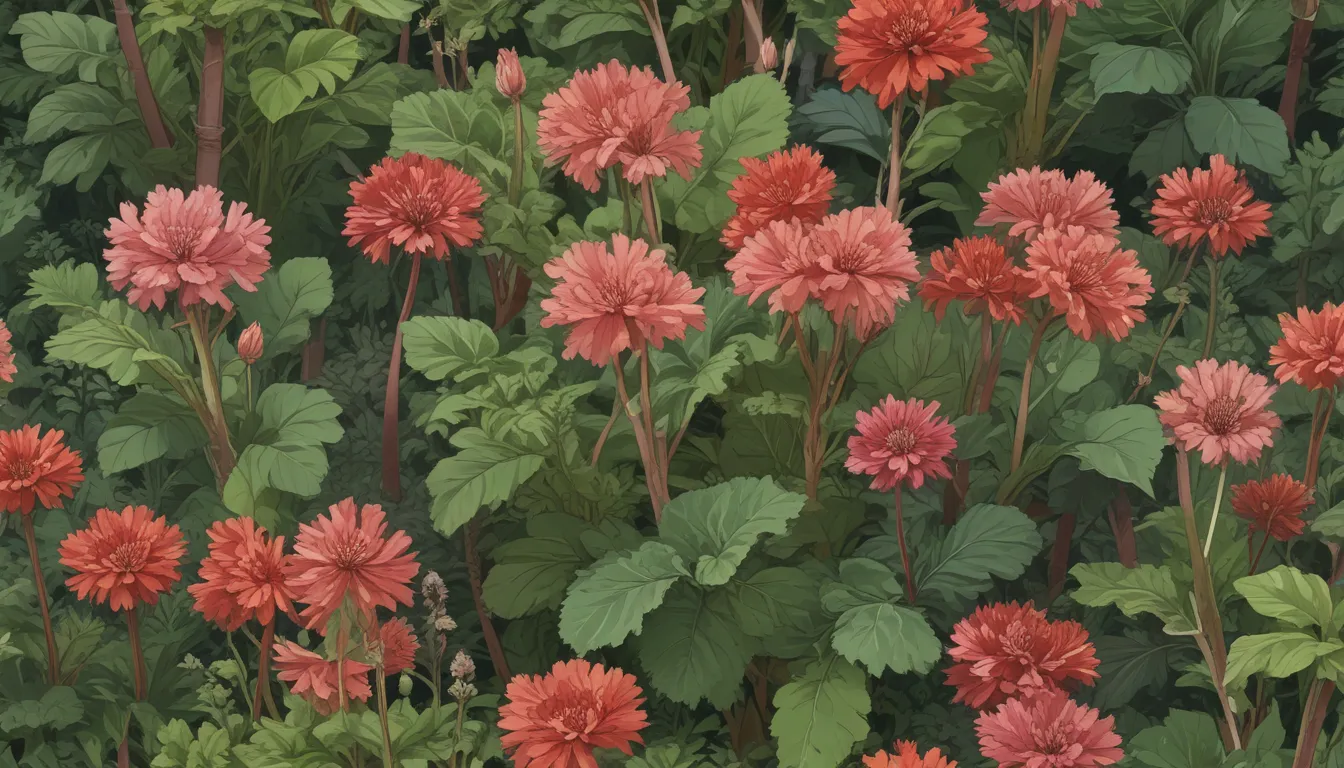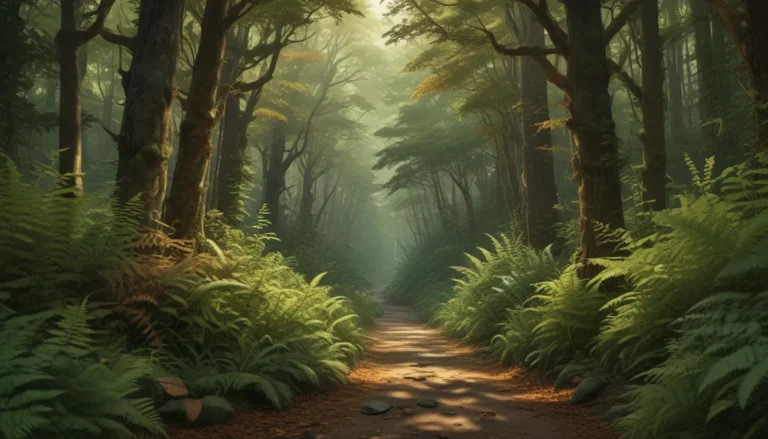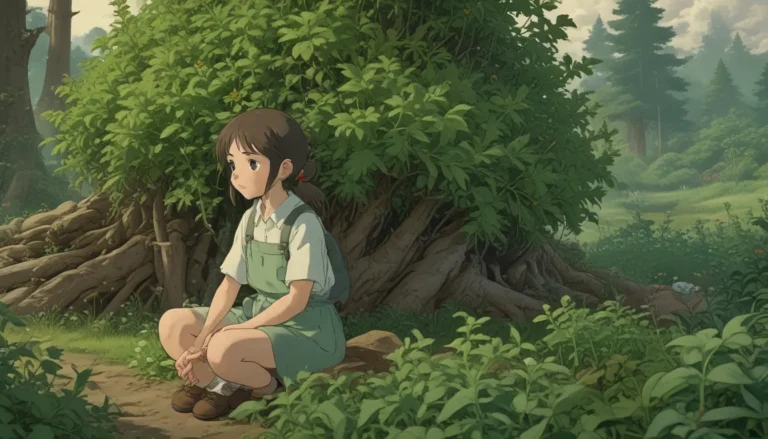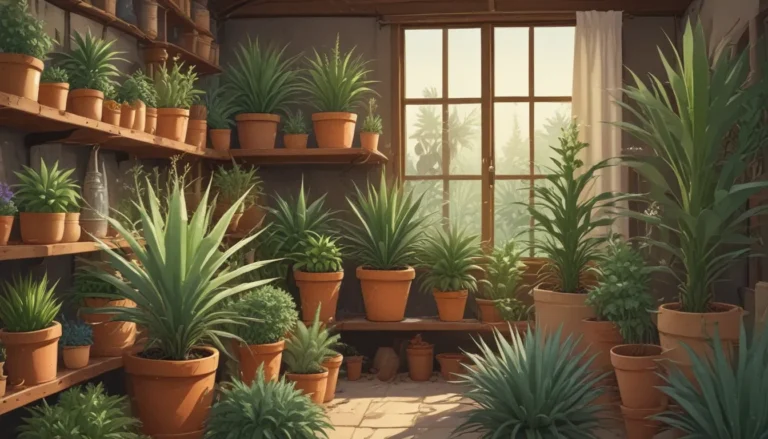Rhubarb: A Comprehensive Guide to Growing and Caring for Rheum x hybridum, R. rhabarbarum Plants

Are you looking to add a vibrant and flavorful perennial to your garden? Look no further than rhubarb! This easily cultivated plant features large ruffled leaves and tall stalks in shades of pink or scarlet with a sharply tart flavor that is ideal for a variety of culinary uses.
In this in-depth guide, we will explore all aspects of growing and caring for rhubarb plants. From cultivation and history to propagation, growing tips, maintenance, harvesting, preserving, and even recipes and cooking ideas, we have you covered!
What Is Rhubarb?
Rhubarb, a hardy perennial belonging to the genus Rheum, is cultivated for its long, edible stalks with a bold, sharp taste. These stalks, ranging in color from light green to deep scarlet, are complemented by large, heart-shaped leaves with a crinkly texture and ruffled edges. The plant emerges in early spring with a fascinating display as the leaves unfurl, resembling pink-tinged green plant brains.
The modern culinary variety, R. x hybridum, is an open-pollination cross that boasts a rich history originating from species like R. rhabarbarum, R. palmatum, and R. rhaponticum. This variety produces beautiful tall spires of white flowers in early summer, adding an elegant touch to garden beds.
Cultivation and History
With origins in southern Siberia and Mongolia, rhubarb has a long history in traditional Chinese medicine dating back to 270 BCE. In Greco-Roman cultures, it was used medicinally and as a valuable commodity along the Silk Road. It wasn’t until the early 18th century that rhubarb transitioned from a medicinal plant to a culinary staple.
Botanically classified as a vegetable, rhubarb is often referred to as a fruit due to its culinary uses. Stalks are commonly cooked with sugar to balance their sharp flavor and used in a variety of dishes, including pies, crumbles, sauces, and jams.
Rhubarb Plant Propagation
While rhubarb can be propagated from seed, the easiest and most reliable method is through crown division. This involves dividing the root ball into sections with healthy rhizomes and buds, ensuring successful plant growth.
- From Seed: Sow seeds in early spring for northern gardens and late summer for southern gardens.
- From Divisions: Divide root balls in early spring or autumn to rejuvenate old plants and establish new ones successfully.
Transplant divisions or nursery stock into well-draining, fertile soil with proper spacing for optimal growth.
How to Grow Rhubarb
Rhubarb thrives in deeply cultivated, fertile, well-draining soil with full sun exposure. Heavy feeders, they require regular watering and benefit from mulching and periodic fertilization. When grown in containers, ensure they are sufficiently large to accommodate the plant’s growth.
Growing Tips
For vibrant and healthy rhubarb plants, consider the following tips:
- Grow in full sun and provide shade from hot afternoon sun if needed.
- Ensure well-draining soil to prevent waterlogging.
- Water plants consistently, providing one to two inches of water per week.
Maintenance
Maintaining rhubarb plants involves mulching in spring, fertilizing in early spring and midsummer, and proper care during the dormant season. Remove old foliage, apply protective mulch, and divide roots every five years to promote vigorous plant growth.
Rhubarb Cultivars to Select
With a vast array of cultivars available, you can choose from various varieties to suit your preferences. Some popular maincrop varieties include:
- Chipman’s Canada Red
- Crimson Red
- Hardy Tarty
- Victoria
Each variety offers unique flavors, colors, and growth characteristics, adding diversity to your garden.
Managing Pests and Disease
Rhubarb plants are relatively pest and disease-resistant, but keep an eye out for common issues like rhubarb curculio, mites, fungal leaf rot, and crown rot. Regular inspection and appropriate treatment methods can help maintain a healthy plant.
Harvesting Rhubarb
Harvest rhubarb stalks from mature plants in the second or third year of growth, ensuring strong and healthy roots for optimal productivity. Early and maincrop varieties can be harvested from spring to summer, with stalks at least 10 inches long ready for picking.
Remember not to harvest all stalks from a single plant at once to avoid stressing the plant. Stalks can be stored in the refrigerator for up to two weeks after harvesting.
Preserving
Preserve the delicious flavor of rhubarb through freezing, drying, or canning. Cut stalks into appropriate sizes and use these methods to extend the shelf life of your harvest for use in a variety of dishes.
Recipes and Cooking Ideas
From classic strawberry rhubarb pie to mouthwatering rhubarb buttermilk sherbet, there are numerous culinary possibilities with rhubarb. Explore different recipes and cooking ideas to incorporate this tangy flavor into your favorite dishes.
Quick Reference Growing Guide
To summarize, here is a quick reference guide for growing and caring for rhubarb plants:
- Plant Type: Perennial herbaceous vegetable
- Hardiness (USDA Zones): 3-8
- Exposure: Full sun
- Height: 1-4 feet
- Spacing: 1-3 feet
- Bloom Time/Season: Spring, summer
- Soil Type: Fertile, loam
- Water Needs: Moderate
- Soil pH: 5.5-6.5
- Companion Planting: Beans, brassicas
- Common Pests and Disease: Rhubarb curculio, mites; fungal leaf rot, crown rot
- Genus: Rheum
- Species: x hybridum, rhabarbarum, rhaponticum
With these guidelines in mind, you can effectively grow and care for vibrant and flavorful rhubarb plants in your garden.
Savories and Sweets
From savory dishes to sweet treats, rhubarb offers a versatile and unique flavor profile that can enhance a wide range of culinary creations. By following proper cultivation practices and maintaining your plants, you can enjoy an abundant harvest of tangy and delicious stalks.
Ready to add some rhubarb to your garden and explore the culinary possibilities it offers? Share your thoughts and experiences with rhubarb cultivation and cooking in the comments below!
Now that you have a comprehensive understanding of how to grow and care for rhubarb plants, you can confidently embark on your gardening journey with this flavorful perennial. Happy planting and cooking with rhubarb!





